The Crescent Moon God is a deity from ancient cultures. It has a big role in moon god mythology. The crescent moon symbol is linked to the god’s power and wisdom. It has fascinated many for its symbolism.
The origins of the Crescent Moon God show its lasting impact. We’ll explore its stories, where compassion, wrath, and wisdom meet.
Key Takeaways
- The Crescent Moon God is a deity with a rich history in ancient cultures
- The crescent moon symbol is associated with the god’s power and wisdom
- Moon god mythology has played a significant role in shaping the stories of the Crescent Moon God
- The crescent moon symbolism has been used to represent the god’s power and wisdom in various cultures
- The stories of the Crescent Moon God offer a unique perspective on compassion, wrath, and wisdom
Origins of the Crescent Moon God in Ancient Mythology
The Crescent Moon God comes from ancient mythology. It was seen as a strong lunar deity. Its meaning and worship changed over time, especially in ancient Greek and Roman cultures. This shows how important moon worship was back then.
In ancient mythology, the Crescent Moon God was linked to fertility, wealth, and nature’s cycles. Its impact was seen in many parts of ancient life, like farming, art, and stories. People believed the lunar deity brought light and life, making it a key part of old religions.
Some important points about the Crescent Moon God’s beginnings and growth are:
- It started in early Mesopotamia, where it was a mighty god.
- It changed over time in different cultures, like ancient Greece and Rome.
- The crescent moon symbol meant fertility, wealth, and nature’s cycles.
These points show how big the Crescent Moon God was in ancient mythology. It still affects us today.
The Sacred Symbols and Attributes of the Moon Deity
The Moon Deity is linked to symbols like the crescent moon, stars, and the night sky. These symbols show its power and wisdom. They are key in lunar symbolism, showing the god’s role in nature’s cycles. The crescent moon is especially important, symbolizing the god’s gentle side.
The moon god attributes include wisdom, compassion, and wrath. These traits are seen in ancient myths. The god’s wisdom helps and protects its followers. Its compassion shows in its nurturing role. The wrath of the Moon Deity is a strong force against those who disobey.
These traits are still honored today in many cultures. The Moon Deity’s symbols and attributes inspire and guide people worldwide. They offer a deeper look into lunar symbolism and the moon’s power.
Tales of Divine Compassion: The Moon God’s Merciful Acts
The moon god stories inspire many, showing the deity’s kindness and mercy. In ancient myths, the moon god protects the weak and heals the sick. Its power grows strong under the full moon, when its compassion shines brightest.
The moon god is known for guiding lost travelers and protecting the innocent. Its kindness also heals, with many healing miracles credited to it. These tales remind us of the moon god’s dedication to its followers.
The moon god’s kindness goes beyond individual acts. It also brings unity and harmony to communities. Many rituals and ceremonies honor the god’s compassion and seek its guidance under the full moon.
- Guiding lost travelers through the darkest of nights
- Protecting the innocent from harm
- Healing miracles under the light of the full moon
These stories remind us of the moon god’s lasting impact. By following its values of kindness and unity, we can build a more compassionate world. A world where everyone thrives under the moon’s gentle light.
The Crescent – Moon God Stories of Compassion, Wrath and Wisdom Through Time
The tales of the Crescent Moon God have been shared for ages in moon god mythology. They tell of compassion, wrath, and wisdom across cultures. These stories have grown, showing the moon’s big role in old myths.
Some key parts of the Crescent Moon God’s stories are:
- Compassion: The god’s kind acts, like protecting the weak and healing the sick by moonlight.
- Wrath: The god’s anger towards the proud and those who don’t keep their promises.
- Wisdom: The god’s lessons through the moon’s cycles, teaching humans to live with nature.
These stories have been kept alive through stories and writings. They help us see why the Crescent Moon God was so important in old times. Today, moon god mythology still captivates us, with its deep meanings and lasting lessons.

The Crescent Moon God’s legacy is seen in many cultures that have honored the lunar deity over time. By looking into these stories, we can learn more about our own lives and the moon’s influence on us.
Divine Wrath: When the Moon God Seeks Justice
The moon god’s wrath is a key part of its story, showing its dedication to divine justice. In old myths, the moon god is seen as a god of justice. Its stories of anger have been told for many years. The moon god wrath is a strong force, aimed at those who don’t keep their promises or show too much pride.
The Tale of the Broken Oath
This story shows the moon god’s anger at broken promises. When people don’t keep their word, the moon god’s wrath teaches a lesson. It shows how important it is to keep your promises.
Punishment of the Prideful
The moon god also punishes those who are too proud. Those who show too much pride or arrogance are humbled. This teaches us the value of being humble and modest.
Lessons from Divine Retribution
The lessons from the moon god’s wrath are clear. Its anger is a powerful reminder to respect and obey. By learning from these stories, we can understand the moon god better. We learn the value of living a good life, following the rules of divine justice and respecting the moon god wrath.
Celestial Wisdom: Teaching Through Lunar Cycles
The Moon God’s celestial wisdom shines through the lunar cycles. These cycles give us a peek into the natural world. They teach us about growth, decay, and renewal.
Studying the lunar cycles helps us understand the Moon God’s celestial wisdom. They show us how everything is connected and how nature works. This wisdom guides us in life, helping us face challenges and make smart choices.

- Embracing change and transformation
- Respecting the natural balance of the world
- Cultivating patience and perseverance
At the core of the Moon God’s celestial wisdom are these lessons. They give us a deep understanding of the world and our role in it.
Rituals and Ceremonies Honoring the Moon God
The Moon God was deeply respected in ancient times. People celebrated him through various rituals and ceremonies. These events showed how much the Moon God meant to them and how lunar cycles were important in their lives. Lunar ceremonies were key to honoring the Moon God’s power.
Some important parts of moon god rituals include:
- Monthly observances to mark the full moon and new moon phases
- Sacred offerings, such as food, drink, and other items, to appease the Moon God
- Prayer and meditation practices to connect with the god’s energy and seek guidance
Joining in these lunar ceremonies helps people understand the Moon God’s role in ancient stories. It also helps them respect and appreciate nature. Moon god rituals and lunar ceremonies still inspire today, showing the lasting impact of this ancient deity.
The Moon God’s Influence on Ancient Civilizations
The moon god’s influence on ancient civilizations is truly fascinating. It shows how this deity shaped culture in many ways. From art to literature, the moon god’s stories are everywhere, showing its big role in ancient lives. Many ancient cultures worshipped the moon god, showing its wide reach.
Some key areas where the moon god’s influence is seen include:
- Agriculture: The moon’s cycles were linked to growing and harvesting crops. This led to lunar calendars and farming practices.
- Art and Architecture: The moon god’s symbols are found in sculptures, paintings, and buildings. It shows its cultural importance.
- Literature and Mythology: Stories about the moon god have been passed down for ages. They’ve influenced ancient literature.
The moon god’s impact on ancient civilizations shows the lasting power of myths. By looking at how the moon god was worshipped, we learn about ancient values and beliefs.
In conclusion, the moon god’s influence on ancient civilizations is a deep and complex topic. It gives us insights into ancient cultures, arts, and literature. By exploring how the moon god was honored, we see its lasting effect on human history.
Modern Interpretations and Contemporary Worship
The modern moon god worship has changed a lot. It now includes neo-pagan practices and efforts to keep traditions alive. This new way of worship has made people interested in the moon god again.
Some key parts of modern moon god worship are:
- Cultural preservation efforts, which aim to protect and promote the traditions and customs associated with the moon god
- Artistic representations, such as paintings, sculptures, and literature, that depict the moon god and its symbolism
- Neo-pagan practices, which involve rituals and ceremonies that honor the moon god and its cycles
These modern ways of worship have brought the moon god back to life. They have also created a sense of community among its followers. As time goes on, we will likely see even more creative ways to honor this ancient deity.
Understanding the Moon God’s Dual Nature
The moon god’s dual nature is a captivating part of ancient myths. It shows both the god’s kind and fierce sides. These stories highlight the moon god’s power and complexity, showing both its mercy and wrath.
The moon god can bring light and darkness. It’s a symbol of hope and guidance, shining in the dark. Yet, it also represents the unknown, reminding us of life’s cycles. This duality makes the moon god a protector and punisher, bestowing both blessings and curses.
The moon god’s dual nature also ties to the feminine and masculine. In some tales, the moon is a goddess, symbolizing nurturing and receptivity. In others, it’s a god, representing action and aggression. This balance shows the moon god’s role in uniting opposites, bringing unity and wholeness.
Some key traits of the moon god’s dual nature are:
- Compassionate and wrathful aspects
- Ability to bring both light and darkness
- Association with the feminine and masculine principles
- Role as a protector and a punisher
- Ability to bring balance and harmony to opposing forces
The moon god’s dual nature is complex and rich. It shows the many sides of the lunar deity. By understanding this, we can appreciate the moon god’s power in ancient myths and its lasting impact today.
Conclusion: Eternal Lessons from the Lunar Deity
Exploring the moon god stories reveals valuable lessons for all. These tales of kindness, anger, and wisdom teach us about empathy, the dangers of pride, and living in sync with nature. They remind us of the importance of compassion and understanding.
The moon god’s stories show us the balance between mercy and justice. They teach us about patience, being flexible, and learning from life’s cycles. These lessons are as relevant today as they were in ancient times.
In today’s world, the moon god offers wisdom to help us face challenges. We can learn from ancient rituals, the moon god’s dual nature, and its beauty in art. These lessons help us understand our role in the universe and the natural world.


The stories of the Crescent Moon God beautifully illustrate the balance between mercy and justice. It’s fascinating how its dual nature reflects the complexities of human nature itself. The way it unites opposites reminds us that harmony often lies in embracing contradictions. Modern worship keeps these ancient teachings alive in creative and meaningful ways. What lessons do you think we can apply from the moon god’s duality in today’s world?